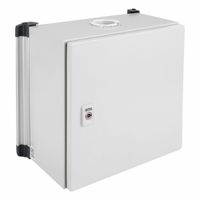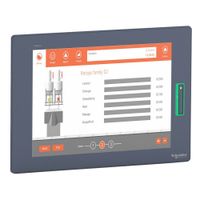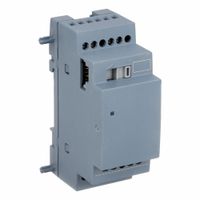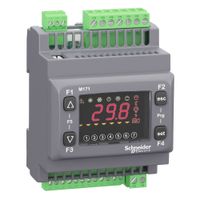Call +(254) 703 030 000 / 751 483 999 / 721 704 777
.....Read More
Frequently Asked Questions
What is the difference between a PLC and an HMI?
A Programmable Logic Controller (PLC) and a Human-Machine Interface (HMI) are both integral components in industrial automation, but they serve distinct functions.
A PLC is a specialized computer used to control machinery and processes. It is designed to withstand harsh industrial environments and is programmed using languages like Ladder Logic, Function Block Diagram, or Structured Text. The primary role of a PLC is to receive inputs from sensors, process these inputs based on a pre-defined program, and send outputs to actuators to control machinery. PLCs are known for their reliability, real-time operation, and ability to handle complex control tasks.
An HMI, on the other hand, is a user interface that allows operators to interact with the control system. It provides a graphical representation of the process, displaying data from the PLC and allowing operators to monitor and control the system. HMIs can range from simple text displays to complex touchscreens with detailed graphics. They are crucial for providing real-time feedback, alarms, and data visualization, enabling operators to make informed decisions and adjustments.
In summary, the key difference lies in their functions: PLCs are the brains of the operation, executing control logic and managing inputs/outputs, while HMIs are the interface, facilitating communication between humans and machines by displaying data and receiving user inputs. Together, they form a cohesive system that enhances automation efficiency and operator interaction.
How do you program a PLC?
To program a PLC (Programmable Logic Controller), follow these steps:
1. **Select the PLC and Software**: Choose a PLC that suits your application needs. Install the corresponding programming software on your computer, such as RSLogix for Allen-Bradley, TIA Portal for Siemens, or GX Developer for Mitsubishi.
2. **Connect to the PLC**: Use the appropriate communication cable (USB, Ethernet, or serial) to connect your computer to the PLC. Ensure the connection is recognized by the software.
3. **Define the Project**: Open the programming software and create a new project. Define the PLC model and configure the hardware settings, including I/O modules and network settings.
4. **Develop the Program**: Write the control logic using one of the standard PLC programming languages: Ladder Logic, Function Block Diagram (FBD), Structured Text (ST), Instruction List (IL), or Sequential Function Chart (SFC). Ladder Logic is the most common for its simplicity and resemblance to electrical schematics.
5. **Address I/O**: Assign addresses to the input and output devices connected to the PLC. This involves mapping physical I/O points to logical addresses in the program.
6. **Test the Program**: Use the software’s simulation tools to test the program logic without physical hardware. This helps identify and correct errors before deployment.
7. **Download to PLC**: Once the program is verified, download it to the PLC using the software. Ensure the PLC is in the correct mode (usually "Program" mode) to accept the download.
8. **Run and Monitor**: Switch the PLC to "Run" mode to execute the program. Use the software’s monitoring tools to observe the program’s operation and make real-time adjustments if necessary.
9. **Document and Backup**: Document the program logic and configuration settings. Create a backup of the program for future reference or troubleshooting.
What are the common applications of PLCs in industrial automation?
Programmable Logic Controllers (PLCs) are integral to industrial automation, offering versatility and reliability. Common applications include:
1. **Assembly Lines**: PLCs control the sequence of operations, ensuring precise timing and coordination of machinery for efficient production.
2. **Material Handling**: They manage conveyor systems, sorters, and automated storage, optimizing the flow of materials and reducing manual intervention.
3. **Process Control**: In industries like chemical, oil, and gas, PLCs regulate variables such as temperature, pressure, and flow rates, maintaining product quality and safety.
4. **Packaging**: PLCs automate packaging lines, controlling machines that fill, seal, label, and palletize products, enhancing speed and accuracy.
5. **Robotics**: They interface with robotic systems, coordinating tasks like welding, painting, and assembly, improving precision and reducing human error.
6. **HVAC Systems**: PLCs manage heating, ventilation, and air conditioning in large facilities, optimizing energy use and maintaining environmental conditions.
7. **Water Treatment**: They control pumps, valves, and chemical dosing in water and wastewater treatment plants, ensuring compliance with environmental standards.
8. **Textile Industry**: PLCs automate weaving, dyeing, and finishing processes, increasing production efficiency and product consistency.
9. **Food and Beverage**: They oversee processes like mixing, cooking, and bottling, ensuring hygiene standards and consistent product quality.
10. **Mining Operations**: PLCs control machinery for drilling, blasting, and material transport, enhancing safety and operational efficiency.
11. **Automotive Manufacturing**: They manage tasks from body assembly to painting, ensuring high precision and throughput.
12. **Energy Management**: PLCs optimize the operation of power plants and renewable energy systems, improving efficiency and reliability.
These applications highlight the PLC's role in enhancing productivity, safety, and efficiency across various industries.
How do HMIs improve industrial automation processes?
Human-Machine Interfaces (HMIs) enhance industrial automation processes by providing intuitive control and monitoring capabilities. They serve as the bridge between operators and machinery, allowing for real-time data visualization and interaction. HMIs improve process efficiency by offering user-friendly interfaces that display critical information such as system status, performance metrics, and alerts, enabling operators to make informed decisions quickly.
By integrating with various industrial control systems like PLCs and SCADA, HMIs facilitate seamless communication and data exchange, leading to improved process coordination and reduced downtime. They support advanced data analytics and visualization tools, which help in identifying trends, predicting maintenance needs, and optimizing operations.
HMIs also enhance safety by providing operators with immediate access to emergency controls and alerts, reducing the risk of accidents. They can be customized to display only relevant information, minimizing operator overload and errors. Additionally, HMIs support remote monitoring and control, allowing operators to manage processes from different locations, which is particularly beneficial for large-scale or hazardous environments.
Furthermore, HMIs contribute to cost savings by streamlining operations and reducing the need for manual interventions. They enable quick troubleshooting and diagnostics, which decreases maintenance time and costs. The adaptability of HMIs to various industrial applications ensures that they can be tailored to specific process requirements, enhancing overall productivity and efficiency.
In summary, HMIs improve industrial automation by enhancing communication, increasing efficiency, ensuring safety, enabling remote operations, and reducing costs, ultimately leading to more streamlined and effective industrial processes.
What are the advantages of using smart relays over traditional relays?
Smart relays offer several advantages over traditional relays:
1. **Enhanced Monitoring and Diagnostics**: Smart relays provide real-time data on system performance, allowing for proactive maintenance and quick identification of faults, reducing downtime.
2. **Improved Control and Automation**: They support advanced control functions and can be integrated into automated systems, enabling more efficient and precise operations.
3. **Remote Access and Management**: Smart relays can be accessed and managed remotely, facilitating easier system adjustments and monitoring without the need for on-site presence.
4. **Energy Efficiency**: By optimizing load management and reducing unnecessary power consumption, smart relays contribute to overall energy savings.
5. **Scalability and Flexibility**: They can be easily reprogrammed or updated to accommodate changes in system requirements, offering greater flexibility compared to traditional relays.
6. **Data Logging and Analysis**: Smart relays can log operational data, which can be analyzed to improve system performance and predict future issues.
7. **Integration with Smart Grids**: They are compatible with smart grid technologies, enhancing grid reliability and efficiency through better demand response and load balancing.
8. **Enhanced Protection Features**: Smart relays offer advanced protection features such as overcurrent, undercurrent, and differential protection, improving system safety.
9. **Cost-Effectiveness**: Although the initial investment may be higher, the long-term savings from reduced maintenance, improved efficiency, and extended equipment life make smart relays cost-effective.
10. **User-Friendly Interfaces**: They often come with intuitive interfaces for easier configuration and operation, reducing the need for specialized training.
11. **Communication Capabilities**: Smart relays support various communication protocols, enabling seamless integration with other devices and systems for comprehensive network management.
How can PLCs be integrated with other industrial systems?
PLCs (Programmable Logic Controllers) can be integrated with other industrial systems through several methods:
1. **Communication Protocols**: PLCs support various communication protocols like Modbus, Profibus, Ethernet/IP, and OPC UA, enabling them to connect with other devices and systems. These protocols facilitate data exchange between PLCs and SCADA systems, HMIs, and other PLCs.
2. **Network Integration**: PLCs can be part of an industrial network, allowing seamless communication with other networked devices. Ethernet-based networks are common, providing high-speed data transfer and integration with IT systems.
3. **I/O Modules**: PLCs can be expanded with additional I/O modules to interface with sensors, actuators, and other field devices. This allows PLCs to gather data from and control various industrial equipment.
4. **Middleware and Gateways**: Middleware solutions and protocol gateways can bridge different communication standards, enabling PLCs to connect with legacy systems or devices using different protocols.
5. **Cloud Connectivity**: Modern PLCs can connect to cloud platforms for data analytics, remote monitoring, and control. This integration supports IoT applications and enhances decision-making through real-time data insights.
6. **Custom Software and APIs**: Custom software applications and APIs can be developed to facilitate integration between PLCs and other systems, allowing for tailored solutions that meet specific industrial needs.
7. **Standardized Interfaces**: Using standardized interfaces like OPC (OLE for Process Control) ensures interoperability between PLCs and other industrial systems, simplifying integration and data exchange.
8. **Edge Computing**: PLCs with edge computing capabilities can process data locally and integrate with other systems for advanced analytics and machine learning applications.
By leveraging these methods, PLCs can be effectively integrated into broader industrial ecosystems, enhancing automation, efficiency, and data-driven decision-making.
What are the key factors to consider when selecting a PLC or HMI for a specific application?
1. **Application Requirements**: Determine the specific needs of the application, including the number of I/O points, processing speed, and communication protocols.
2. **Scalability**: Consider future expansion possibilities. Choose a PLC or HMI that can accommodate additional I/O modules or features.
3. **Environment**: Assess the operating environment. Select devices that can withstand temperature extremes, humidity, dust, or vibration if necessary.
4. **Compatibility**: Ensure compatibility with existing systems and equipment. Check for support of required communication protocols like Ethernet/IP, Modbus, or Profibus.
5. **User Interface**: For HMIs, evaluate the ease of use, screen size, resolution, and touch capabilities. Consider the need for multilingual support or custom graphics.
6. **Programming Software**: Look for user-friendly programming software with features like simulation, debugging, and online editing. Check for compliance with standards like IEC 61131-3.
7. **Reliability and Support**: Choose reputable brands known for reliability. Consider the availability of technical support, documentation, and training.
8. **Cost**: Balance the initial cost with long-term benefits. Consider total cost of ownership, including maintenance and potential downtime.
9. **Integration**: Evaluate how easily the PLC or HMI can integrate with other systems, such as SCADA or MES.
10. **Security**: Ensure the device has robust security features to protect against unauthorized access and cyber threats.
11. **Power Supply**: Verify the power requirements and ensure compatibility with the available power sources.
12. **Regulatory Compliance**: Ensure the device meets industry standards and regulations relevant to the application.
13. **Vendor Reputation**: Consider the vendor's reputation for quality, innovation, and customer service.
14. **Customization**: Determine if the PLC or HMI can be customized to meet specific application needs.




